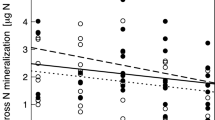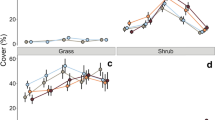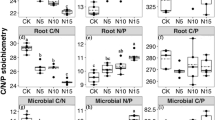Abstract
Higher plant diversity reduces nitrate leaching by complementary resource use, while its relation to leaching of other N species is unclear. We determined the effects of plant species richness, functional group richness, and the presence of specific functional groups on ammonium, dissolved organic N (DON), and total dissolved N (TDN) leaching from grassland in the first 4 years after conversion from fertilized arable land to unfertilized grassland. On 62 experimental plots in Jena, Germany, with 1–60 plant species and 1–4 functional groups (legumes, grasses, tall herbs, small herbs), nitrate, ammonium, and TDN concentrations in soil solution (0–0.3 m soil layer) were measured fortnightly during 4 years. DON concentrations were calculated by subtracting inorganic N from TDN. Nitrogen concentrations were multiplied with modeled downward water fluxes to obtain N leaching. DON leaching contributed most to TDN leaching (64 ± SD 4% of TDN). Ammonium leaching was unaffected by plant diversity. Increasing species richness decreased DON leaching in the fourth year. We attribute this finding to enhanced use of DON as a C and N source and enhanced mineralization of DON by soil microorganisms. An increase of species richness decreased TDN leaching likely driven by the complementary use of nitrate by diverse mixtures. Legumes increased DON and TDN leaching likely because of their N\(_{2}\)-fixing ability and higher litter production. Grasses decreased TDN leaching because of more exhaustive use of nitrate and water. Our results demonstrate that increasing plant species richness decreases leaching of DON and TDN.





Similar content being viewed by others
References
Anderson JPE, Domsch KH (1978) A physiological method for the quantitative measurement of microbial biomass in soil. Soil Biol Biochem 10:215–221
Bardgett RD, Streeter TC, Bol R (2003) Soil microbes compete effectively with plants for organic-nitrogen inputs to temperate grasslands. Ecology 84:1277–1287. doi:10.1890/0012-9658(2003)084[1277:SMCEWP]2.0.CO;2
Başaran M, Erpul G, Tercan AE, Çanga MR (2008) The effects of land use changes on some soil properties in İndaği Mountain Pass - Çankırı, Turkey. Environ Monit Assess 136:101–119. doi:10.1007/s10661-007-9668-4
Bessler H, Oelmann Y, Roscher C, Buchmann N, Scherer-Lorenzen M, Schulze ED, Temperton VM, Wilcke W, Engels C (2012) Nitrogen uptake by grassland communities: contribution of N\(_{2}\) fixation, facilitation, complementarity, and species dominance. Plant Soil 358:301–322. doi:10.1007/s11104-012-1181-z
Bessler H, Temperton VM, Roscher C, Buchmann N, Schmid B, Schulze ED, Weisser WW, Engels C (2009) Aboveground overyielding in grassland mixtures is associated with reduced biomass partitioning to belowground organs. Ecology 90:1520–1530. doi:10.1890/08-0867.1
Bingham MA, Biondini M (2011) Nitrate leaching as a function of plant community richness and composition, and the scaling of soil nutrients, in a restored temperate grassland. Plant Ecol 212:413–422. doi:10.1007/s11258-010-9832-8
Christian DG, Riche AB (1998) Nitrate leaching losses under Miscanthus grass planted on a silty clay loam soil. Soil Use Manage 14:131–135
Dijkstra FA, West JB, Hobbie SE, Reich PB, Trost J (2007) Plant diversity, CO\(_{2}\), and N influence inorganic and organic N leaching in grasslands. Ecology 88:490–500. doi:10.1890/06-0733
DVWK (ed) (1996) Ermittlung der Verdunstung von Land- und Wasserflächen. DVWK-Merkblätter zur Wasserwirtschaft 238. Deutscher Verband für Wasserwirtschaft und Kulturbau e. V. (DVWK), Bonn, Germany
Eisenhauer N, Bessler H, Engels C, Gleixner G, Habekost M, Milcu A, Partsch S, Sabais ACW, Scherber C, Steinbeiss S, Weigelt A, Weisser WW, Scheu S (2010) Plant diversity effects on soil microorganisms support the singular hypothesis. Ecology 91:485–496. doi:10.1890/08-2338.1
Eisenhauer N, Milcu A, Sabais ACW, Bessler H, Brenner J, Engels C, Klarner B, Maraun M, Partsch S, Roscher C, Schonert F, Temperton VM, Thomisch K, Weigelt A, Weisser WW, Scheu S (2011) Plant diversity surpasses plant functional groups and plant productivity as driver of soil biota in the long term. Plos One 6:e16055. doi:10.1371/journal.pone.0016055
Eisenhauer N, Reich PB, Scheu S (2012) Increasing plant diversity effects on productivity with time due to delayed soil biota effects on plants. Basic Appl Ecol 13:571–578. doi:10.1016/j.baae.2012.09.002
Eisenhauer N, Dobies T, Cesarz S, Hobbie SE, Meyer RJ, Worm K, Reich PB (2013) Plant diversity effects on soil food webs are stronger than those of elevated CO\(_{2}\) and N deposition in a long-term grassland experiment. Proc Natl Acad Sci USA 110:6889–6894. doi:10.1073/pnas.1217382110
Ellenberg H (1996) Vegetation Mitteleuropas mit den Alpen in ökologischer, dynamischer und historischer Sicht, 5th edn. Ulmer, Stuttgart
Grace JB (2006) Structural Equation Modeling and Natural Systems. Cambridge University Press, Cambridge, UK
Hawkesford M, Horst W, Kichey T, Lambers H, Schjoerring J, Skrumsager Møller I, White P (2012) Chapter 6—functions of macronutrients. In: Marschner P (ed) Marschner’s nutrition of higher plants, 3rd edn. Academic Press, London, pp 135–189. doi: 10.1016/B978-0-12-384905-2.00006-6
Hector A, Schmid B, Beierkuhnlein C, Caldeira MC, Diemer M, Dimitrakopoulos PG, Finn JA, Freitas H, Giller PS, Good J, Harris R, Högberg P, Huss-Danell K, Joshi J, Jumpponen A, Körner C, Leadley PW, Loreau M, Minns A, Mulder CPH, O’Donovan G, Otway SJ, Pereira JS, Prinz A, Read DJ, Scherer-Lorenzen M, Schulze ED, Siamantziouras ASD, Spehn EM, Terry AC, Troumbis AY, Woodward FI, Yachi S, Lawton JH (1999) Plant diversity and productivity experiments in European grasslands. Science 286:1123–1127. doi:10.1126/science.286.5442.1123
Hoffmann K, Bivour W, Früh B, Koßmann M, Voß PH (2014) Klimauntersuchungen in Jena für die Anpassung an den Klimawandel und seine erwarteten Folgen. Berichte des Deutschen Wetterdienstes 243. Deutscher Wetterdienst, Offenbach am Main, Germany
Hooper DU, Vitousek PM (1998) Effects of plant composition and diversity on nutrient cycling. Ecol Monogr 68:121–149. doi:10.2307/2657146
Jiang XL, Zhang WG, Wang G (2007) Effects of different components of diversity on productivity in artificial plant communities. Ecol Res 22:629–634. doi:10.1007/s11284-006-0307-2
Jones DL, Shannon D, Murphy DV, Farrar J (2004) Role of dissolved organic nitrogen (DON) in soil N cycling in grassland soils. Soil Biol Biochem 36:749–756. doi:10.1016/j.soilbio.2004.01.003
Leimer S, Kreutziger Y, Rosenkranz S, Beßler H, Engels C, Hildebrandt A, Oelmann Y, Weisser WW, Wirth C, Wilcke W (2014a) Plant diversity effects on the water balance of an experimental grassland. Ecohydrology 7:1378–1391. doi:10.1002/eco.1464
Leimer S, Wirth C, Oelmann Y, Wilcke W (2014b) Biodiversity effects on nitrate concentrations in soil solution: a Bayesian model. Biogeochemistry 118:141–157. doi:10.1007/s10533-013-9913-6
Leimer S, Oelmann Y, Wirth C, Wilcke W (2015) Time matters for plant diversity effects on nitrate leaching from temperate grassland. Agr Ecosyst Environ 211:155–163. doi:10.1016/j.agee.2015.06.002
Loreau M, Naeem S, Inchausti P, Bengtsson J, Grime JP, Hector A, Hooper DU, Huston MA, Raffaelli D, Schmid B, Tilman D, Wardle DA (2001) Biodiversity and ecosystem functioning: Current knowledge and future challenges. Science 294:804–808. doi:10.1126/science.1064088
Marquard E, Weigelt A, Temperton VM, Roscher C, Schumacher J, Buchmann N, Fischer M, Weisser WW, Schmid B (2009) Plant species richness and functional composition drive overyielding in a six-year grassland experiment. Ecology 90:3290–3302. doi:10.1890/09-0069.1
McKane RB, Johnson LC, Shaver GR, Nadelhoffer KJ, Rastetter EB, Fry B, Giblin AE, Kielland K, Kwiatkowski BL, Laundre JA, Murray G (2002) Resource-based niches provide a basis for plant species diversity and dominance in arctic tundra. Nature 415:68–71. doi:10.1038/415068a
Mokany K, Ash J, Roxburgh S (2008) Functional identity is more important than diversity in influencing ecosystem processes in a temperate native grassland. J Ecol 96:884–893. doi:10.1111/j.1365-2745.2008.01395.x
Neff JC, Chapin FS III, Vitousek PM (2003) Breaks in the cycle: dissolved organic nitrogen in terrestrial ecosystems. Front Ecol Environ 1:205–211. doi:10.1890/1540-9295(2003) 001[0205:BITCDO]2.0.CO;2
Niklaus PA, Kandeler E, Leadley PW, Schmid B, Tscherko D, Körner C (2001) A link between plant diversity, elevated CO\(_{2}\) and soil nitrate. Oecologia 127:540–548. doi:10.1007/s004420000612
Nippert JB, Knapp AK (2007) Soil water partitioning contributes to species coexistence in tallgrass prairie. Oikos 116:1017–1029. doi:10.1111/j.2007.0030-1299.15630.x
Oelmann Y, Kreutziger Y, Temperton VM, Buchmann N, Roscher C, Schumacher J, Schulze ED, Weisser WW, Wilcke W (2007a) Nitrogen and phosphorus budgets in experimental grasslands of variable diversity. J Environ Qual 36:396–407. doi:10.2134/jeq2006.0217
Oelmann Y, Wilcke W, Temperton VM, Buchmann N, Roscher C, Schumacher J, Schulze ED, Weisser WW (2007b) Soil and plant nitrogen pools as related to plant diversity in an experimental grassland. Soil Sci Soc Am J 71:720–729. doi:10.2136/sssaj2006.0205
Oelmann Y, Buchmann N, Gleixner G, Habekost M, Roscher C, Rosenkranz S, Schulze ED, Steinbeiss S, Temperton VM, Weigelt A, Weisser WW, Wilcke W (2011) Plant diversity effects on aboveground and belowground N pools in temperate grassland ecosystems: Development in the first 5 years after establishment. Global Biogeochem Cy 25:GB2014. doi: 10.1029/2010GB003869
Pinheiro J, Bates D, DebRoy S, Sarkar D, R Core Team (2014) nlme: Linear and Nonlinear Mixed Effects Models. URL http://CRAN.R-project.org/package=nlme, R package version 3.1-117
R Core Team (2014) R: A Language and Environment for Statistical Computing. R Foundation for Statistical Computing, Vienna, Austria, URL http://www.R-project.org/
Ravenek JM, Bessler H, Engels C, Scherer-Lorenzen M, Gessler A, Gockele A, De Luca E, Temperton VM, Ebeling A, Roscher C, Schmid B, Weisser WW, Wirth C, de Kroon H, Weigelt A, Mommer L (2014) Long-term study of root biomass in a biodiversity experiment reveals shifts in diversity effects over time. Oikos 123:1528–1536. doi:10.1111/oik.01502
Roscher C, Schumacher J, Baade J, Wilcke W, Gleixner G, Weisser WW (2004) The role of biodiversity for element cycling and trophic interactions: an experimental approach in a grassland community. Basic Appl Ecol 5:107–121. doi:10.1078/1439-1791-00216
Roscher C, Thein S, Schmid B, Scherer-Lorenzen M (2008) Complementary nitrogen use among potentially dominant species in a biodiversity experiment varies between two years. J Ecol 96:477–488. doi:10.1111/j.1365-2745.2008.01353.x
Rosenkranz S, Wilcke W, Eisenhauer N, Oelmann Y (2012) Net ammonification as influenced by plant diversity in experimental grassland. Soil Biol Biochem 48:78–87. doi:10.1016/j.soilbio.2012.01.008
Scherer-Lorenzen M, Palmborg C, Prinz A, Schulze ED (2003) The role of plant diversity and composition for nitrate leaching in grasslands. Ecology 84:1539–1552. doi:10.1890/0012-9658(2003)084[1539:TROPDA]2.0.CO;2
Scheu S (1992) Automated measurement of the respiratory response of soil microcompartments: Active microbial biomass in earthworm faeces. Soil Biol Biochem 24:1113–1118
Schilling KE, Spooner J (2006) Effects of watershed-scale land use change on stream nitrate concentrations. J Environ Qual 35:2132–2145. doi:10.2134/jeq2006.0157
Seitzinger SP, Sanders RW (1997) Contribution of dissolved organic nitrogen from rivers to estuarine eutrophication. Mar Ecol Prog Ser 159:1–12. doi:10.3354/meps159001
Spehn EM, Joshi J, Schmid B, Diemer M, Körner C (2000) Above-ground resource use increases with plant species richness in experimental grassland ecosystems. Funct Ecol 14:326–337
Spehn EM, Hector A, Joshi J, Scherer-Lorenzen M, Schmid B, Bazeley-White E, Beierkuhnlein C, Caldeira MC, Diemer M, Dimitrakopoulos PG, Finn JA, Freitas H, Giller PS, Good J, Harris R, Högberg P, Huss-Danell K, Jumpponen A, Koricheva J, Leadley PW, Loreau M, Minns A, Mulder CPH, O’Donovan G, Otway SJ, Palmborg C, Pereira JS, Pfisterer AB, Prinz A, Read DJ, Schulze ED, Siamantziouras ASD, Terry AC, Troumbis AY, Woodward FI, Yachi S, Lawton JH (2005) Ecosystem effects of biodiversity manipulations in European grasslands. Ecol Monogr 75:37–63. doi:10.1890/03-4101
Steinbeiss S, Beßler H, Engels C, Temperton VM, Buchmann N, Roscher C, Kreutziger Y, Baade J, Habekost M, Gleixner G (2008) Plant diversity positively affects short-term soil carbon storage in experimental grasslands. Glob Change Biol 14:2937–2949. doi:10.1111/j.1365-2486.2008.01697.x
Stevenson FJ, Cole MA (1999) Cycles of soil: carbon, nitrogen, phosphorus, sulfur, micronutrients, 2nd edn. Wiley, New York
Strecker T, González Macé O, Scheu S, Eisenhauer N (2016) Functional composition of plant communities determines the spatial and temporal stability of soil microbial properties in a long-term plant diversity experiment. Oikos. doi:10.1111/oik.03181
Streeter TC, Bol R, Bardgett RD (2000) Amino acids as a nitrogen source in temperate upland grasslands: the use of dual labelled (\(^{13}\)C, \(^{15}\)N) glycine to test for direct uptake by dominant grasses. Rapid Commun Mass Spectrom 14:1351–1355. doi:10.1002/1097-0231(20000815)14:15<1351::AID-RCM23>3.0.CO;2-9
Temperton VM, Mwangi PN, Scherer-Lorenzen M, Schmid B, Buchmann N (2007) Positive interactions between nitrogen-fixing legumes and four different neighbouring species in a biodiversity experiment. Oecologia 151:190–205. doi:10.1007/s00442-006-0576-z
Tilman D, Wedin D, Knops J (1996) Productivity and sustainability influenced by biodiversity in grassland ecosystems. Nature 379:718–720. doi:10.1038/379718a0
Tilman D, Reich PB, Knops J, Wedin D, Mielke T, Lehman C (2001) Diversity and productivity in a long-term grassland experiment. Science 294:843–845. doi:10.1126/science.1060391
van Kessel C, Clough T, van Groenigen JW (2009) Dissolved organic nitrogen: an overlooked pathway of nitrogen loss from agricultural systems? J Environ Qual 38:393–401. doi:10.2134/jeq2008.0277
Verheyen K, Bulteel H, Palmborg C, Olivié B, Nijs I, Raes D, Muys B (2008) Can complementarity in water use help to explain diversity-productivity relationships in experimental grassland plots? Oecologia 156:351–361. doi:10.1007/s00442-008-0998-x
Weigelt A, Bol R, Bardgett RD (2005) Preferential uptake of soil nitrogen forms by grassland plant species. Oecologia 142:627–635. doi:10.1007/s00442-004-1765-2
Weihermüller L, Siemens J, Deurer M, Knoblauch S, Rupp H, Göttlein A, Pütz T (2007) In situ soil water extraction: A review. J Environ Qual 36:1735–1748. doi:10.2134/jeq2007.0218
Acknowledgements
We thank the many people who helped with the management of the experiment and in particular the initiators, E.-D. Schulze, B. Schmid, and W. W. Weisser, and the scientific coordinator A. Ebeling. We are grateful to V. M. Temperton for her comments on the manuscript. Thanks to all the helpers who assisted during the weeding campaigns. We thank the two reviewers for their helpful comments. The Jena Experiment is funded by the Deutsche Forschungsgemeinschaft (DFG, FOR 456 & 1451, Wi 1601/4) and the Swiss National Science Foundation (SNSF, 200021E-131195/1), with additional support from the Friedrich Schiller University Jena and the Max Planck Society.
Author information
Authors and Affiliations
Corresponding author
Additional information
Responsible Editor: Edith Bai
Rights and permissions
About this article
Cite this article
Leimer, S., Oelmann, Y., Eisenhauer, N. et al. Mechanisms behind plant diversity effects on inorganic and organic N leaching from temperate grassland. Biogeochemistry 131, 339–353 (2016). https://doi.org/10.1007/s10533-016-0283-8
Received:
Accepted:
Published:
Issue Date:
DOI: https://doi.org/10.1007/s10533-016-0283-8




